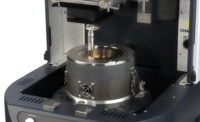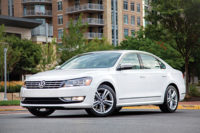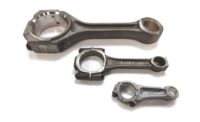Understanding Engineered Surfaces in Automotive
Tribometers and 3-D optical microscopes meet the demand for more stringent surface finish testing and measurement requirements.




With concerns about greenhouse gas emissions and limited fossil fuels availability, U.S. government regulations, such as the Corporate Average Fuel Economy (CAFE), have been put in place since 1975 to regulate the fuel economy of cars and light trucks. More recently, in June 2015, the Environmental Protection Agency (EPA) and the Transportation Department drafted new carbon-emissions standards for big trucks, which mandate that all big trucks built in 2021 or after must be as much as 24 percent more fuel efficient and emit as much as 24 percent less carbon emissions than an equivalent truck built in 2018. Similar regulations and recommendations are being made throughout the world.
Automotive manufacturers and their suppliers are exploring many different approaches for increasing fuel economy of gas- and diesel-powered vehicles. An important area of focus is the reduction of energy losses associated with friction, often referred to as parasitic energy losses. Fuel efficiency increases as more energy becomes available to propel the vehicle and less energy is wasted on frictional losses. Currently, less than 15% of fuel energy is converted to useful energy that drives the vehicle and roughly 10% of energy input is consumed by friction. The development of engineered surfaces of automotive components with low-friction and controlled surface topography has been reported to improve fuel efficiency by 3-5%. There are huge benefits from even a few percent of improvement in fuel efficiency considering the relatively low energy conversion rate of gas- and diesel-powered vehicles. For example, in the United States, a three-mpg increase in fuel economy would save one million barrels of oil per day, save consumers as much as $25 billion per year in fuel costs, and cut carbon dioxide emissions by 140 million tons per year, according to a 2010 U.S. EPA press release.
To properly design and manufacture engineered parts with desired surface conditions, it is necessary to use appropriate technologies to test and measure surface characteristics. Testing of engineered components under various conditions can help predict real-world product functionality. Quantitative measurements of surface texture and roughness are also important because these parameters critically influence system performance.
Testing and Controlling Friction
Tribology is the science behind how friction, wear and lubrication affect interactive surfaces in motion. Controlling friction and wear is a complex task. Friction coefficients of materials are not absolute, but instead represent values obtained under specific use conditions. The system environment can impact not only how a testing procedure is done, but the test results as well. Understanding the temperature, humidity, pressure and other factors is important to engineering parts that move more easily or limit wear and tear. For example, there are a number of ways to reduce the friction between surfaces:
- Make the surfaces more smooth by reducing surface roughness either by using finer surface finishing steps or by depositing super-smooth coating materials, such as diamond-like carbon (DLC)
- Improve lubrication by using fluids with lower viscosity and improved additives
- Reduce the contact area between the surfaces by using ball bearings.
To optimize these improvements, tribology testing systems can be used to do standardized and custom-designed tests under specialized use conditions. Universal tribometers can perform multiple tests in a single platform with interchangeable modules, and can help manufacturers better understand and control the wide range of complex parameters that impact part movement and wear.
Characterizing Surface Topography
It is equally important to measure and characterize the surface topography of automotive components. Tribology testing can indicate how a part is functioning, but accurate measurement of surface texture parameters can reveal precisely why a part is behaving a certain way. Precise surface metrology enables engineers to better understand many factors impacting the behavior of moving parts. Understanding surface friction and wear and their underlying causes is critical to the development, manufacture and maintenance of automotive parts, such as bearings, seals, shafts, brake components, and much more.
Three-dimensional (3-D) optical microscopy that uses white light interferometry (WLI) is one of the most accurate, repeatable, and versatile methods for precision surface metrology. Instruments based on this technology have been used to measure material surfaces from automotive industry R&D labs and QC/QA facilities to manufacturing floors and production lines over an extremely broad range of applications.
Visualizing Surfaces with High-Fidelity Imaging
In addition to precision surface metrology, clear imaging of sample surfaces serves key inspection needs in QC/QA. The newest 3-D optical microscopy technology adds imaging capabilities with the ease-of use and display advantages usually only available with confocal microscopy, giving users the ability to easily and quickly obtain not only high-resolution and repeatable surface topography measurements, but also high-quality images and 3-D visualization of sample topography.
Understanding the Complete Picture
Surfaces that interact need to be tested against actual conditions to get a good understanding of how they will perform. These considerations impact everything from fuel economy and greenhouse gas emissions to the safety and reliability of vehicles over time. Tribology testing systems reveal the results of friction and wear. Similarly, 3-D optical microscopes can provide insights to the complex causes and effects of friction and wear. Combining high-end 3-D surface optical metrology with high-fidelity imaging of the material surfaces provides additional avenues for feature or defect characterization of functional surfaces. Accurate metrology data along with clear images give users the complete surface characterization story. Through this combination of testing, quantitative measurement, and visualization of surfaces, automotive manufacturers and their suppliers enable compliance with increasingly strict standards and regulations, while guaranteeing that their customers receive the best performing products.
Looking for a reprint of this article?
From high-res PDFs to custom plaques, order your copy today!







